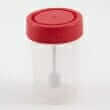Background
- Urine therapy refers to use of one's urine to maintain health, to prevent or cure sickness, to enhance beauty, or to promote meditation and spiritual enlightenment. Urine has been ingested, injected, or applied topically.
- Urine therapy can be traced back as far as 5,000 years to early civilizations such as the Aztecs, ancient Egyptians, ancient Chinese, and Native Americans. It is believed that the origin of this practice comes from certain religious rites among Hindus, where it is called amaroli in tantric religious traditions. Medically, urine is referred to as "plasma ultrafiltrate." Advocates of urotherapy claim that this treatment is effective for dry skin, cancer, and numerous other diseases and disorders.
- Research has revealed components of urine such as urea, hormones, and enzymes. Many of these components have been commercially isolated and marketed. For example, urokinase (an enzyme that promotes the break-up of blood clots) is used in drug form and sold as a thrombolytic for unblocking coronary arteries. Furthermore, luteinizing hormone and follicle stimulating hormone are the active components in Pergonal, a drug used to stimulate fertility in women. Urea is used in several creams to promote healthy skin.
- Current researchers are investigating urotherapy in the treatment of AIDS and cancer.
References
- Christopher L, Fitzgerald O. A clinical trial of an oral urea preparation (Carbamine) in peptic ulcer therapy. Ir.J Med Sci 1968;7(6):243-253.
View Abstract - Collen D, Lijnen HR. New approaches to thrombolytic therapy. Arteriosclerosis 1984;4(6):579-585.
View Abstract - Danopoulos ED, Danopoulos IE. Letter: Urea treatment of skin malignancies. Lancet 6-8-1974;1(7867):1161.
View Abstract - Danopoulos ED, Danopoulou IE. Eleven years experience of oral urea treatment in liver malignancies. Clin Oncol. 1981;7(4):281-289.
View Abstract - Danopoulos ED, Danopoulou IE. Letter: Regression of liver cancer with oral urea. Lancet 1-26-1974;1(7848):132.
View Abstract - Eldor J. Urotherapy for patients with cancer. Med Hypotheses 1997;48(4):309-315.
View Abstract - Gail M, Beach J, Dark A, et al. A double-blind randomized trial of low-dose oral urea to prevent sickle cell crises. J Chronic.Dis. 1982;35(2):151-161.
View Abstract - Gupta RK, Huth JF, Korn EL, Morton DL. Prognostic significance of urinary antigen analysis by enzyme-linked immunosorbent assay in melanoma patients. Diagn.Immunol. 1983;1(4):303-309.
View Abstract - Hooper TL, Rahman M, Magell J. Oral urea in the treatment of colo-rectal liver metastases. Clin Oncol. 1984;10(4):341-344.
View Abstract - Krueger JM, Pappenheimer JR, Karnovsky ML. Sleep-promoting effects of muramyl peptides. Proc Natl.Acad Sci U.S.A 1982;79(19):6102-6106.
View Abstract - Mills MH, Faunce TA. Melatonin supplementation from early morning auto-urine drinking. Med Hypotheses 1991;36(3):195-199.
View Abstract - Padzik H, Paszko Z, Pronaszko A. Purification of pituitary gonadotropins from the urine of women after menopause and trials of separating luteinizing from follicle stimulating hormone. Arch Immunol.Ther Exp (Warsz.) 1969;17(5):655-673.
View Abstract - Pariser S, Katz A. Treatment of sickle cell trait hematuria with oral urea. J Urol 1994;151(2):401-403.
View Abstract - Sevcik J, Masek K. The interaction of immunomodulatory muramyl dipeptide with peripheral 5-HT receptors: overview of the current state. Int J Immunopharmacol. 1999;21(3):227-232.
View Abstract - Treatment of sickle cell crisis with urea in invert sugar. A controlled trial. Cooperative urea trials group. JAMA 5-27-1974;228(9):1125-1128.
View Abstract







